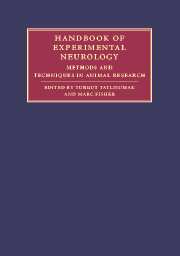Book contents
- Frontmatter
- Contents
- List of contributors
- Part I Principles and general methods
- 1 Introduction: Animal modeling – a precious tool for developing remedies to neurological diseases
- 2 Ethical issues, welfare laws, and regulations
- 3 Housing, feeding, and maintenance of rodents
- 4 Identification of individual animals
- 5 Analgesia, anesthesia, and postoperative care in laboratory animals
- 6 Euthanasia in small animals
- 7 Various surgical procedures in rodents
- 8 Genetically engineered animals
- 9 Imaging in experimental neurology
- 10 Safety in animal facilities
- 11 Behavioral testing in small-animal models: ischemic stroke
- 12 Methods for analyzing brain tissue
- 13 Targeting molecular constructs of cellular function and injury through in vitro and in vivo experimental models
- 14 Neuroimmunology and immune-related neuropathologies
- 15 Animal models of sex differences in non-reproductive brain functions
- 16 The ependymal route for central nervous system gene therapy
- 17 Neural transplantation
- Part II Experimental models of major neurological diseases
- Index
- References
3 - Housing, feeding, and maintenance of rodents
Published online by Cambridge University Press: 04 November 2009
- Frontmatter
- Contents
- List of contributors
- Part I Principles and general methods
- 1 Introduction: Animal modeling – a precious tool for developing remedies to neurological diseases
- 2 Ethical issues, welfare laws, and regulations
- 3 Housing, feeding, and maintenance of rodents
- 4 Identification of individual animals
- 5 Analgesia, anesthesia, and postoperative care in laboratory animals
- 6 Euthanasia in small animals
- 7 Various surgical procedures in rodents
- 8 Genetically engineered animals
- 9 Imaging in experimental neurology
- 10 Safety in animal facilities
- 11 Behavioral testing in small-animal models: ischemic stroke
- 12 Methods for analyzing brain tissue
- 13 Targeting molecular constructs of cellular function and injury through in vitro and in vivo experimental models
- 14 Neuroimmunology and immune-related neuropathologies
- 15 Animal models of sex differences in non-reproductive brain functions
- 16 The ependymal route for central nervous system gene therapy
- 17 Neural transplantation
- Part II Experimental models of major neurological diseases
- Index
- References
Summary
Introduction
Article 5 in Directive 86/609 of the Council of the European Communities states:
All experimental animals shall be provided with housing, an environment, at least some freedom of movement, food, water and care which are appropriate to their health and well being:
any restriction on the extent to which an experimental animal can satisfy its physiological and ethological needs shall be limited to the absolute minimum; …
Animal needs are summarized in a report on farm animals by the Brambell Committee which referred to the provision of “Five Freedoms.” These were reported as:
Freedom from malnutrition;
Freedom from injury and disease;
Freedom from thermal and physical discomfort;
Freedom from fear and stress;
Freedom to express most normal patterns of behaviour.
These freedoms are not confined solely to farm animals but are applicable to all animals maintained in captivity, including those kept within laboratories as breeding stock or for experimental use.
The scientist and the animal technician must be constantly aware that animals housed in the laboratory either for breeding or scientific studies lack the self-sufficiency of their wild counterparts. They are completely dependent on him, or her, for all these physiological and ethological needs; they have a limited ability to vary or improve their environmental conditions by seeking warmer or cooler areas, are unable to vary their food or seek out additional supplies should they become depleted, and have no control over access to liquid as this is usually from a single source; and the space in which they exercise, mate, and socialize is controlled and confined.
- Type
- Chapter
- Information
- Handbook of Experimental NeurologyMethods and Techniques in Animal Research, pp. 19 - 32Publisher: Cambridge University PressPrint publication year: 2006



